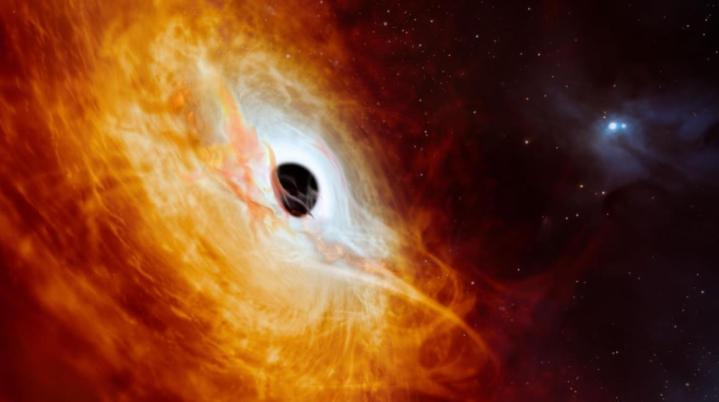A recently discovered monster black hole feasts on so much nearby material that it’s the fastest-growing of its kind on record. The beefy black hole is devouring the equivalent mass of our sun every single day, making it a record-breaker in more ways than one.
“The incredible rate of growth also means a huge release of light and heat,” said lead researcher Christian Wolf of The Australian National University in a statement. “So, this is also the most luminous known object in the universe. It’s 500 trillion times brighter than our sun.”

Known as J059-4351, it is a type of object called a quasar, where the supermassive black hole at the heart of a galaxy is so massive and active that the galactic core around it glows brightly. The black hole at the center has a mass of around 17 billion times that of the sun, making it much more massive than the relatively diminutive black hole at the center of our galaxy (Sagittarius A*, with a mass 4.3 billion times that of the sun) or even the famous, first-photographed black hole in Messier 87, which is 6.5 billion times the mass of the sun.
The discovery was first made using a telescope in Australia, then confirmed with the European Southern Observatory’s Very Large Telescope. The researchers saw the very active, hot, and fast-moving region around the black hole and were able to calculate information about its feeding pattern based on that. The material swirls around the black hole and is gradually consumed by the black hole as it falls past the event horizon.
“It looks like a gigantic and magnetic storm cell with temperatures of 10,000 degrees Celsius, lightning everywhere, and winds blowing so fast they would go around Earth in a second,” Wolf said. “This storm cell is seven light-years across, which is 50 percent more than the distance from our solar system to the next star in the Galaxy, Alpha Centauri.”
One reason that this particular black hole is so enormous is that it is very distant, so looking at it is like looking back in time to an earlier period when the universe was different from how it is today.
“The light from this black hole has traveled over 12 billion years to reach us,” co-author Rachel Webster from the University of Melbourne explained. “In the adolescent universe, matter was moving chaotically and feeding hungry black holes. Today, stars are moving orderly at safe distances and only rarely plunge into black holes.”
The research is published in the journal Nature Astronomy.



